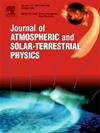Evaluating the performance of the rainfall forecast model based on GNSS ZTD and ERA5 CAPE for Hong Kong
IF 1.9
4区 地球科学
Q3 GEOCHEMISTRY & GEOPHYSICS
Journal of Atmospheric and Solar-Terrestrial Physics
Pub Date : 2025-04-26
DOI:10.1016/j.jastp.2025.106525
引用次数: 0
Abstract
The Earth's troposphere delay provides valuable information for rainfall forecasting. Tropospheric delay products (e.g., Zenith Total Delay (ZTD)) derived from the Global Navigation Satellite System (GNSS) have become an indispensable approach for accessing tropospheric information. Several studies have established rainfall forecast models based on the GNSS-derived ZTD. However, the forecast predictors used in these models were all developed from the ZTD or its highly correlated parameters, resulting in high virtual forecast results. Therefore, a novel predictor, Convective Available Potential Energy (CAPE), was introduced to enhance the existing rainfall forecast model and is composed of the ZTD and CAPE rainfall (ZCR) model. The ZCR model includes six predictors: the ZTD value, ZTD variation, its derivation, CAPE value, CAPE variation, and its derivation. Hourly ZTD, CAPE, and rainfall data from three stations in Hong Kong with a time span of one year were collected to perform the experiment. The forecast accuracy of the ZCR model was evaluated using the corrected forecasted rate (CFR) and false alarm rate (FAR). The optimal thresholds of the predictors were determined using the percentile method, following the highest CFR and lowest FAR. The forecast accuracies of the ZTD and CAPE models, composed of their own three predictors, were comparable at the seasonal and monthly scales. Finally, we combined the ZTD and CAPE predictors into a ZCR model. Compared with the single ZTD or CAPE models, the combined ZCR model can significantly improve the accuracy of the FAR, with the CFR and FAR values of 93.53 % and 26.82 %, respectively. And the ZCR model also illustrates that the forecast accuracy on the monthly scale is higher than that on the seasonal scale.
评估基于GNSS ZTD和ERA5 CAPE的香港雨量预报模式的表现
地球对流层的延迟为降雨预报提供了有价值的信息。来自全球导航卫星系统(GNSS)的对流层延迟产品(如天顶总延迟(ZTD))已成为获取对流层信息不可或缺的方法。一些研究基于gnss衍生的ZTD建立了降雨预报模型。然而,这些模型中使用的预测因子都是从ZTD或其高度相关的参数中开发出来的,因此预测结果的虚值较高。为此,引入对流有效势能(CAPE)预测因子对现有降雨预报模式进行了改进,该预测因子由ZTD和CAPE降雨(ZCR)模式组成。ZCR模型包括6个预测因子:ZTD值、ZTD变化及其衍生、CAPE值、CAPE变化及其衍生。实验收集了香港三个站点一年的逐时ZTD、CAPE和降雨量数据。利用修正预测率(CFR)和虚警率(FAR)对ZCR模型的预测精度进行了评价。使用百分位数法确定预测因子的最佳阈值,遵循最高CFR和最低FAR。ZTD和CAPE模式的预报精度由它们自己的三个预测因子组成,在季节和月尺度上具有可比性。最后,我们将ZTD和CAPE预测因子组合成ZCR模型。与单一ZTD或CAPE模型相比,组合ZCR模型可以显著提高FAR的精度,CFR和FAR分别达到93.53%和26.82%。ZCR模型在月尺度上的预报精度高于季节尺度。
本文章由计算机程序翻译,如有差异,请以英文原文为准。
求助全文
约1分钟内获得全文
求助全文
来源期刊

Journal of Atmospheric and Solar-Terrestrial Physics
地学-地球化学与地球物理
CiteScore
4.10
自引率
5.30%
发文量
95
审稿时长
6 months
期刊介绍:
The Journal of Atmospheric and Solar-Terrestrial Physics (JASTP) is an international journal concerned with the inter-disciplinary science of the Earth''s atmospheric and space environment, especially the highly varied and highly variable physical phenomena that occur in this natural laboratory and the processes that couple them.
The journal covers the physical processes operating in the troposphere, stratosphere, mesosphere, thermosphere, ionosphere, magnetosphere, the Sun, interplanetary medium, and heliosphere. Phenomena occurring in other "spheres", solar influences on climate, and supporting laboratory measurements are also considered. The journal deals especially with the coupling between the different regions.
Solar flares, coronal mass ejections, and other energetic events on the Sun create interesting and important perturbations in the near-Earth space environment. The physics of such "space weather" is central to the Journal of Atmospheric and Solar-Terrestrial Physics and the journal welcomes papers that lead in the direction of a predictive understanding of the coupled system. Regarding the upper atmosphere, the subjects of aeronomy, geomagnetism and geoelectricity, auroral phenomena, radio wave propagation, and plasma instabilities, are examples within the broad field of solar-terrestrial physics which emphasise the energy exchange between the solar wind, the magnetospheric and ionospheric plasmas, and the neutral gas. In the lower atmosphere, topics covered range from mesoscale to global scale dynamics, to atmospheric electricity, lightning and its effects, and to anthropogenic changes.
 求助内容:
求助内容: 应助结果提醒方式:
应助结果提醒方式:


